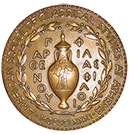Imagine yourself in the center of ancient Athens, the Agora. Here you can admire the cavalry parading proudly along the streets, or watch with wonder as chariots race down the Panathenaic Way during the festival of the goddess Athena. If you climb up to the Acropolis, you are struck by the beauty of the 250 horses carved in marble on the Parthenon. If you walk out to the Kerameikos, you can see ceramic artists painting scenes with horses on clay pots of all shapes and sizes. Or if a funeral is in progress, mourning family members might be erecting monuments commemorating the deceased’s association with horses, or even laying a beloved horse to rest.
Horses were the most admired and prized animals in ancient Greece. They were also very expensive to buy and to care for, so they were owned and trained by the wealthy class. They played an important part in the life of ancient Athenians, especially in racing, warfare and religion. Horses were depicted on many forms of art throughout all periods of ancient Greek history. They were illustrated on clay vases, marble sculptures, silver coins and bronze statues. The ancient Greeks loved horses so much, that they even gave their children names containing the word “hippos”, which means horse.
Much information about the different roles that horses played in ancient Athens comes from ancient literature. In his book On Horsemanship, the ancient Greek historian Xenophon writes about the proper ways to care for and train a horse. More evidence comes from dedicatory inscriptions on stone, victor lists from the ancient athletic games and records of the Athenian cavalry. The recent discovery in the ancient cemetery at Phaleron of eighteen well-preserved horse skeletons provides new information and raises new questions about these roles. This exhibition highlights the love and admiration that ancient Athenians had for their horses and also illustrates the important part that horses played in many aspects of Athenian life.
This plump little jug was a special shape used by Athenians at their annual festival ofthe wine-god Dionysos. The smaller versions were made for children and feature playful scenes with pets and toys. Here we see a boy holding a victory wreath (now faded) and leading his bridled horse, showing that he may have won a horse race.
Chous, or wine jug with a boy and his horse
Attic red-figure, ca. 400 BCE - Agora Excavations
Ephorate of Antiquities of the City of Athens







